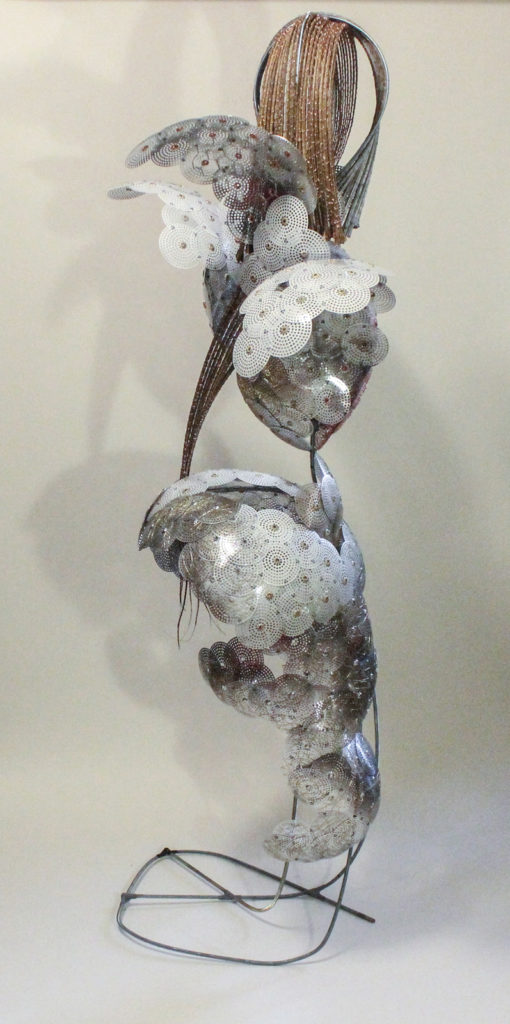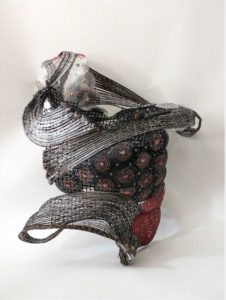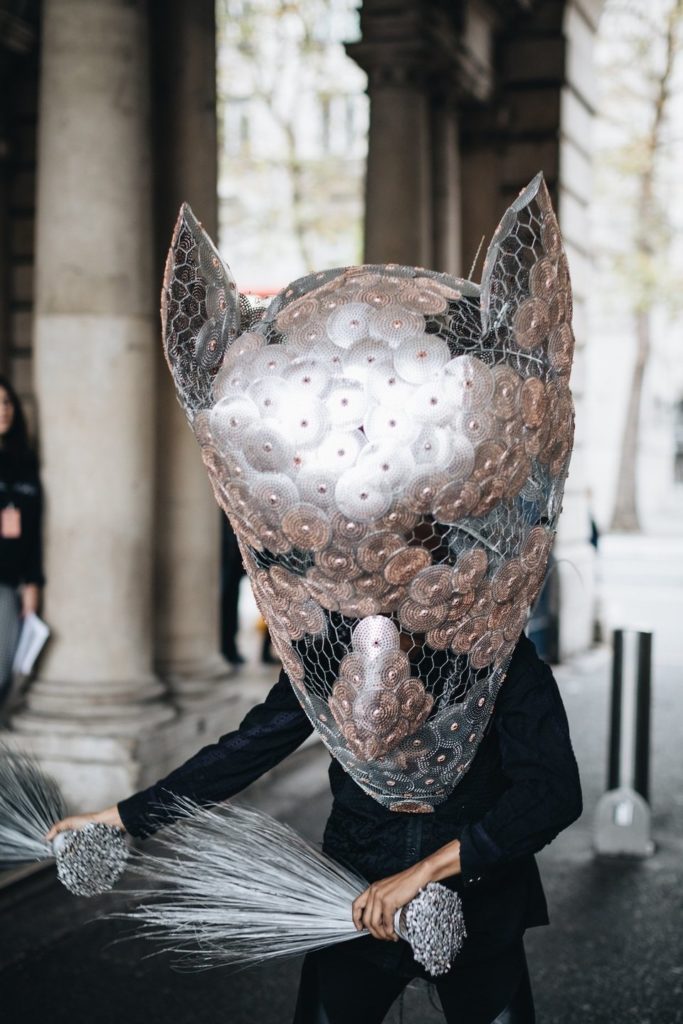
I want to continue using my work to empower, to heal and transform lives and to show how that worked for me and how that could be an aesthetic strategy for helping others. I intend to continue questioning the relationship between Africa and the West: where are we going, what are we doing? I also want to support my community to share what I learned and be an example for people who are marginalized based on identity.
Rob Perrée in conversation with Adejoke Tugbiyele.
The Plea – Stop the Violence, 2018.
Adejoke Tugbiyele
I live by example
Adejoke Tugbiyele was born in the US and partly raised in Nigeria. Since her parents are Nigerian migrants and since the Nigerian culture plays a significant role in her work, it makes sense to call her a Nigerian-American artist. She lives in Harlem. Her partner currently lives in Cape Town, South Africa.
I have followed her work already a couple of years. The exhibition she has at the moment in Charlottesville, Virginia, is the main reason to have an interview with her.
We meet in Harlem. On an unusually warm morning in February.
Many people who write about your work talk about the artist and the activist or the activist artist. What are you? An activist? An artist? A combination of both?
I had my activism days. That was parallel to my just coming out. I am a late bloomer, having come out in my thirties after my divorce. At that time there was the passion and the desire to speak my truth. Now, I want to do so in a different way. I feel more like an advocate now. I am more interested in living by example. I don’t feel the need to have a ‘loud speaker’ and besides, when I was calling myself an activist, I did not realise that it was a job description for some people. It is a job. That is not what I wanted. It is not my calling to be an activist. It is not my personality. I am inspired to perform as a maker. That does not mean that I don’t speak my voice, that I don’t tell the truth and that I don’t have opinions.

Installation view, Second Street Gallery, Charlotsville, 2018.
Do you believe that art can change things?
Absolutely. It can change hearts, It can change minds, especially if you define art very broadly. There is craft involved in how you work and interact with people. It can enlighten people. For instance through the relationships you make during the process of working and being an artist.

Guardian Angel, 2017.
You can find many themes in your work: race, gender, religion, history, sexuality, identity. Is there a general theme?
It all ties back to the idea of living by example. We have come to a place and time that we cannot afford to use a language that embraces some people and excludes others. My work has a universal quality. It is rooted and grounded in my cultural heritage. I identify as a black woman, as a Yoruba woman. But that aesthetic and my values can be found in other cultures as well.
Can you clarify the influence of Yoruba culture.
You see it in the material I use, but also in my process. I talk a lot about the concept of energy, the energy that we use to define our character. To make things happen, to envision a brighter future. That is a very strong concept. There is also the concept of the inner head, meaning, finding the essence of a person. And I sometimes use colors significant within Yoruba aesthetics and spirituality, for instance white as being the essence of a good character. And we Yoruba people talk about the distinctions between death, afterlife and speaking with ancestors. Of course I do this all in contemporary terms and with the materials I think are important to use for my work.
Your materials are always a combination of existing and new.
I like the juxtaposition of natural and manmade or industrial material. I try to find a balance between them, as a poetic metaphor for the balance between human beings with a different background and coming from a different culture, as a metaphor for finding harmony in our relations with other people.
Past and present find each other often in your work.
I think a lot about the relationship between Africa and the West, in pre-colonial sense, and also about the future. I use a lot of silver and other metallics to suggest that futurist aesthetic. Going back and forth I work with time and space. I try to bring up questions, to contribute to the discourse on Africa’s relationship to the West.

Heart, 2017.
When I look at your sculptures and try to name them, I get confused. Are they objects, are they human beings? Do they seduce me? Do they scare me? What are they?
That is the beauty of them. I like the duality, the beauty and the grotesque, normality and ‘abnormality’. I call them hybrids. Thanks to the English, there is a specific word you can find to describe anything (Laughter). But the works are also transparent. They are figures that invite you in to go deeper, to ask questions. They are about disguise and masking. What are we hiding for and why are we hiding? They are also androgynous. They are masculine or feminine, depending on how you hold up the mirror. I hope that the viewer can see him- or her self in the work and that he or she asks more questions
In what way has your work changed over the last couple of years.
Now I think more in a painterly way. I ask myself in what way color can contribute to my sculptures, to the meaning of my sculptures. It is the result of experimenting and working in my studio. And performance plays a more important role in my work.

Shifting the Waves, performance, London, 2017.
What is the relationship between your sculptures and your performances?
In my figures I suggest movement. Look at the bindings for instance. They are about gestures. I put myself in that space and use the sculptures as a costume. I control the temperature of the space. I try to be the mediator between the objects and the objective. I play with time, bring a theatrical aspect to it. In London I invited the people in to wave the brooms. Brooms refer to cleansing in all possible ways. Literally, but they also refer to cleansing the spirits, the natural resources, our emotional climate, etcetera.
You were talking about your purpose, the purpose of your work?
I want to continue using my work to empower, to heal and transform lives and to show how that worked for me and how that could be an aesthetic strategy for helping others. I intend to continue questioning the relationship between Africa and the West: where are we going, what are we doing? I also want to support my community to share what I learned and be an example for people who are marginalized based on identity.
That is a lot.
I have a whole life to do it.
What do you mean by your aesthetic?
I like to talk about a spiritual movement. My work has an essence of universality. In the craft, in the way I am working there is a meditation element, there is a prayer going on. There is art in everything in life if you do things to their fully potential and if you push the boundaries.

Installation view, Second Street Gallery, Charlotsville, 2018.
In several interviews you mention the colleagues who influenced you.
Zanele Muholi has been a very powerful voice, not only in South-Africa, on black lesbian issues. She is a pioneer because she gave a platform for these issues. She inspired black lesbian artists who want to use their art to speak about them. Chakaia Booker was my studio critic at graduate school. For two years she gave me feedback on my work, on my possibilities as an artist. I worked for El Anatsui with the pyramid he had to install in Washington during Earth Matters at the National Museum for African Art – Smithsonian. He invited me to manage the hanging works he presented in Amsterdam (ArtZuid). He mentored me in many ways. I like his work because he lets the material speak. His work is generous and he himself is also generous – He is a mirror of his work. As far as Rotimi Fani-Kayode, I had not heard of any gay Nigerian that specifically used his artwork as a platform to speak on issues of identity concerning Nigerian/Black gay men. Like Zanele does for black lesbians in South Africa and beyond.
Do you know already in what direction your work will develop?
I think that more people will be involved in my work. The theatrical aspect of my performances will grow. My partner and I wish to develop a foundation called Mlamli Foundation, that aims to transform poverty by collaborating with artists, musicians and other creative people. My work will be more engaging. We are going to work with communities more.
